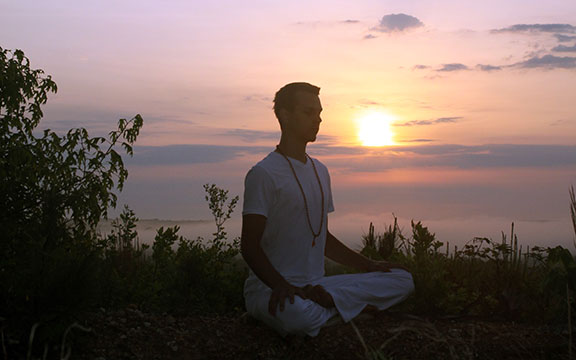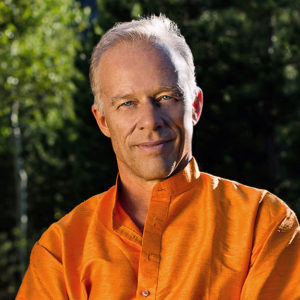 In this interview, renowned Yoga teacher Rod Stryker explores the four motivating forces in life and how a steady spiritual practice can bring those to fruition in a way that helps us live happy, healthy and fulfilling lives. Stryker believes that the aim of practice is to remember our wholeness, as well as to rest in peace and healing—inherent qualities with which we all come into life. In this interview, Rod offers inspiring advice on the benefits of a regular Yoga practice. He expounds on Maharishi Patanjali’s teachings on practice and the essential goal of Yoga.
In this interview, renowned Yoga teacher Rod Stryker explores the four motivating forces in life and how a steady spiritual practice can bring those to fruition in a way that helps us live happy, healthy and fulfilling lives. Stryker believes that the aim of practice is to remember our wholeness, as well as to rest in peace and healing—inherent qualities with which we all come into life. In this interview, Rod offers inspiring advice on the benefits of a regular Yoga practice. He expounds on Maharishi Patanjali’s teachings on practice and the essential goal of Yoga.
Integral Yoga Magazine (IYM): How does Sri Patanjali define practice in the Yoga Sutras?
Rod Stryker (RS): Patanjali defines practice as abhyasa, which means: to be in the endeavor. That means we are doing something—not that we do it perfectly, but we are endeavoring to do it. The critical term that Patanjali adds to his description of abhyasa is “tatra,” which means “there.” So, practice is the endeavor to be there. Before we begin to consider the notion of cultivating a regular practice, we should seriously consider the “there” to which Patanjali refers. Patanjali, the seminal voice of the Yoga tradition, is telling us that practice is the endeavor to be in the state of Yoga. In Book 1, sutra 2, Patanjali defines the state of Yoga as nirodha, referring to a quality of stilling the mind. Therefore, Yoga practice, according to him, is the endeavor to be in that stillness. Moreover, in the next sutra Patanjali says that the “there” of Yoga practice is the experience of Self essence, or what most of us call the higher Self.
If we think about practice as enabling us to rest in that authentic Self and be “there,” what that tells us is that we have the potential of holding in our consciousness,
the awareness that—no matter what happens in our lives, whether we are in the midst of great success or great turmoil or even turbulence, disappointment or
heartache—there’s a part of us that remains at rest, a part of us that remains always free. This is the very meaning of the word, Purusha—the term Patanjali uses to describe the soul, or that which rests in the city of the body. That is the literal meaning of Purusha (from Puru, city, and sha, to rest).
IYM: In these challenging times, particularly economically, how do we rest in the authentic Self?
RS: It’s true that we all live in a world that’s not completely dedicated to us having security and freedom all the time—we have to seek these things out, and invariably they slip through our fingers. But if we could always be mindful of that part of us that is at rest, that is at ease, which stands on the sands of eternity, then every moment of our lives would be different. We could step back from our busy lives and ask these questions: How much of my happiness is dependent on the outside world? How much of my happiness is circumstantial? For most of us, our happiness is dependent on having more things that we want and fewer things that we don’t want. The moment that changes, so that there are more things in our lives that we don’t want, that’s called unhappiness. Yogis, like most people, need to start developing a certain level of self-mastery over the mind, and that is really the purpose of our practice.
What Yoga holds out to each of us is the promise that we can live and not be dependent on circumstances, where our happiness is completely shaped by the external world. Practice—mindful practice, true yogic practice—that moves us to the quality of stillness, that allows us to rest in the knowledge of the part of us that is never-changing, is one of the few things that humans have ever developed that allows our happiness to flourish unconditionally. It teaches us to rely on internal awareness, a companionship with that part of us that is always free, always at ease and, by its nature, is satchidananda. That is what practice is about. Practice is not an end in itself, it’s a means to take us there. That’s why it’s vital to study scripture, why it’s essential to listen to the satsang of enlightened masters—because the perennial teachings of illumined masters, and the rishis that provided our ancient texts, remind us of what “there” looks like.
IYM: With the proliferation of asana classes today, what role does meditation play in a regular sadhana?
RS: I find that I have to answer this question often. In other words, give people a reason to explore meditation. I’m a classicist when it comes to Yoga practice. There’s no doubt the asanas are supportive, but they are a preparation for meditation. People often ask me, “Why should I meditate?” Meditation, in the Yoga community—though not so much in Integral Yoga, but, in the larger Yoga world—is less than fully embraced. Asanas have been wildly embraced, but meditation not as much. It’s vital to acknowledge that there are many spiritual traditions that don’t use asana, that are strictly meditative traditions. Sri Patanjali himself, said that Yoga practice is not about the body, it’s about the mind—stilling the mind so you can rest in the very place we’ve been talking about.
IYM: Why is meditation so important?
RS: Our mind holds the key to our happiness. The mind is also the doorway to the eternal. Thus, meditation is essential if we are to experience true and lasting happiness. A critical teaching in the Yoga tradition is that we all walk through life with fear, whether we are conscious of it or not; fear overshadows every moment of our lives. This is described in the Yoga Sutras. Patanjali tells us that even pleasurable experiences are painful. Why? When life is going great, a part of our mind fears that our happiness will not last. Painful experiences are not only painful, but create suffering because a part of us fears that it’s going to last forever. Meditation allows us to move beyond this fundamental fear. It allows us to begin to access a part of us that is fearless; access an experience where we are touching, tasting and abiding in something that cannot be lost or taken away, something that is permanent, enduring, everlasting.
IYM: Is it through establishing a regular sadhana that the promise of Yoga that you earlier mentioned, is fulfilled?
RS: Yes. A regular, sincere Yoga practice, or sadhana, changes who we are because it begins to imbibe us with Truth––our Higher Nature. Over time, we become gradually imbued with the experience that a part of us is indestructible, immortal thus, not vulnerable to the shifting tides of the world. As this becomes our frame of reference, it gradually begins to reduce this fundamental fear that plagues so much of humanity. The sages provided us with the methodologies so that we could live, breathe and walk free from suffering.
In the Gita, we find a description that says that a yogi is one who sleeps during the day and is awake at night. One way this can be interpreted is the idea that human beings, who live their lives without the benefits that meditation and practice provide, only experience a respite from their anxieties, restlessness, fears and unfulfilled goals when they sleep at night. But that experience is an unconscious one; nothing more than a temporary disconnect from their pain and suffering—in other words, none of their unwanted thoughts have been transformed or overcome. Upon rising, the first thought they have is the very last one they had before they went to sleep. People might wonder, “Why is that bad?” After all, most of us love sleep for the very reason that it is a respite from worry, doubt and uncertainty.
What the Gita is pointing to is that yogis remain awake while others are asleep. This means we stay alert to our higher nature, even while we sleep. We don’t fall into the dark ignorance of slumber. Imagine being an illumined master, always conscious of the Divine within your own heart, and then dropping into the unconsciousness of sleep. This would be painful! Why? Because: You would no longer be conscious of the most exalted awareness of which a human being is capable. For such a being, sleep is actually a painful experience. That’s why yogis practice Yoga Nidra. Your Guru, Swami Satchidananda, of course, was a master of this as well.
When we hear about the sleepless yogis it’s not as though they are up, restless in the middle of the night; they are both deeply in a state of complete rest and at the same time fully conscious of the underlying reality of who they are. Much of our need for sleep has to do with our need of relief from all our unsettled, unresolved feelings, emotions, anxieties and projections that stir deep within us. However, if we utilize the methodologies of Yoga Nidra, deep relaxation, meditation, asana and we are eating properly and our lifestyle is in tune with nature, then our system is essentially in harmony such that we need less and less sleep.
The other part of this teaching from the Gita suggests that most human beings are awake during the day—in other words, we are in fight or flight mode—yet this is the time that a yogi “sleeps.” This means that a yogi is deeply restive even in the midst of worldly activities. There are a few things that humankind has ever developed that make this possible—that during the day, in the midst of our activities we can be at peace and at night we can be awake to the infinite. Thus, meditation is both the pinnacle of Yoga practice and one of humankind’s most sublime creations.
 About Rod Stryker:
About Rod Stryker:
Yogarupa Rod Stryker is a world-renowned Yoga and meditation teacher, guiding and sharing his wisdom for 40 years. He is the founder of ParaYoga®, and the author of The Four Desires: Creating a Life of Purpose, Happiness, Prosperity, and Freedom. He is the creator of the app Sanctuary, a premier destination for all levels of those wanting to experience the life-changing practices of meditation and Yoga nidra, also known as Enlightened Sleep. Rod has dedicated his life to improving lives through his lectures, writing, practice, teaching, leadership, service and family life. For more information, please visit: www.parayoga.com

